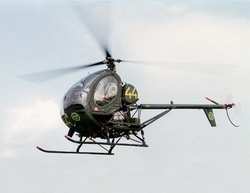Country Music Star Troy Gentry Fatally Injured When The Aircraft Went Down
The NTSB has released its preliminary report from an accident which fatally injured country music star Troy Gentry September 8.

According to the report, the Schweizer 269C-1 helicopter, N204HF, operated by Helicopter Flight Services, was substantially damaged during collision with terrain while performing a forced landing to Runway 01 at Flying W Airport (N14), Medford, New Jersey. The commercial pilot and passenger were fatally injured. Visual meteorological conditions prevailed, and no flight plan was filed for the personal flight which was conducted under the provisions of 14 Code of Federal Regulations Part 91. According to the chief flight instructor for the operator, the purpose of the flight was to provide an orientation/pleasure flight to Gentry, who was scheduled to perform in a concert on the airport later that evening.
Several minutes after takeoff, the pilot reported over the airport UNICOM frequency that he was unable to control engine rpm with throttle inputs. He reported he could "roll" the twistgrip, but that there was no corresponding change in engine rpm when he did so. The company flight instructor and another certificated helicopter flight instructor were monitoring the frequency and engaged the pilot in conversation about potential courses of action to affect the subsequent landing. Options discussed included a shallow approach to a run-on landing, or a power-off, autorotational descent to landing. The pilot elected to stop the engine and perform an autorotation, which was a familiar procedure he had performed numerous times in the past. Prior to entering the autorotation, the pilot was advised to initiate the maneuver over the runway.
The company flight instructor reported that the helicopter entered the autorotation about 950 ft above ground level, and that the helicopter was quiet during its descent "because the engine was off." During the descent, the rotor rpm decayed to the point where the instructor could see the individual rotor blades. The helicopter descended from view prior to reaching the runway threshold and the sounds of impact were heard. Both instructors reported that a high-pitched "whine" could be heard from the helicopter during the latter portion of the descent. A video forwarded by local police showed the helicopter south of the runway as it entered what appeared to be a descent profile consistent with an autorotation. Toward the end of the video, the descent profile became more vertical and the rate of descent increased before the helicopter descended out of view. No sound could be heard from the helicopter.
The pilot held commercial and instructor pilot certificates, each with ratings for rotorcraft/helicopter and instrument helicopter. His most recent FAA second-class medical certificate was issued April 12, 2017.
Excerpts of the pilot's logbook revealed he had logged 480.9 total hours of flight experience. It was estimated that he had accrued over 300 total hours of flight experience in the accident helicopter make and model. The last entry logged was for 1.2 hours in the accident helicopter on the day of the accident.
The company training records indicated the pilot had received the training required by the operator for employment as a flight instructor, and his last airman competency check was completed satisfactorily on April 19, 2017 in the accident helicopter.

According to FAA records, the helicopter was manufactured in 2000 and had accrued approximately 7,900 total aircraft hours. Its most recent 100-hour inspection was completed August 17, 2017 at 7,884 total aircraft hours.
The wreckage was examined at the accident site, and all major components were accounted for at the scene. The initial ground scar was about 10 ft prior to the main wreckage, which was about 220 ft prior to the threshold of runway 01 and aligned with the runway.
The cockpit was significantly deformed by impact damage, and the tailboom was separated at the fuselage. The engine and main transmission remained mounted in the airframe, and all main rotor blades were secured in their respective grips, which remained attached to the main rotor head and mast. The pitch-change link for the yellow rotor blade was fractured, with fracture signatures consistent with overstress. Each of the three blades was bent significantly at its respective blade root. The blades showed little to no damage along their respective spans toward the blade tips, which was consistent with low rotor rpm at ground contact. Flight control continuity was established from the individual flight controls, through breaks, to the main rotor head and tail rotor. Drivetrain continuity was also established to the main and tail rotors.
The engine was rotated by hand at the cooling fan, and continuity was confirmed from the powertrain through the valvetrain, to the accessory section. Compression was confirmed on all cylinders using the thumb method. The magnetos were removed, actuated with a drill, and spark was produced at all terminal leads. Borescope examination of each cylinder revealed signatures consistent with normal wear, with no anomalies noted.
The carburetor was separated from the engine, displayed impact damage, and was found near the initial ground scar. The throttle and mixture arms were actuated by hand and moved smoothly through their respective ranges. The filter screen was removed, and was absent of debris. The carburetor contained fuel which appeared absent of water and debris. The collective control and jackshaft assembly as well as the associated throttle cable, push-pull tube, and bellcrank assemblies were retained for further examination at the NTSB Materials Laboratory.
(Image from file. Not accident aircraft)
 ANN's Daily Aero-Term (04.26.24): DETRESFA (Distress Phrase)
ANN's Daily Aero-Term (04.26.24): DETRESFA (Distress Phrase) ANN's Daily Aero-Linx (04.26.24)
ANN's Daily Aero-Linx (04.26.24) Airborne 04.22.24: Rotor X Worsens, Airport Fees 4 FNB?, USMC Drone Pilot
Airborne 04.22.24: Rotor X Worsens, Airport Fees 4 FNB?, USMC Drone Pilot Airborne 04.24.24: INTEGRAL E, Elixir USA, M700 RVSM
Airborne 04.24.24: INTEGRAL E, Elixir USA, M700 RVSM Airborne-NextGen 04.23.24: UAVOS UVH 170, magni650 Engine, World eVTOL Directory
Airborne-NextGen 04.23.24: UAVOS UVH 170, magni650 Engine, World eVTOL Directory




